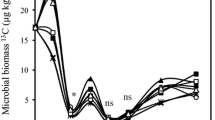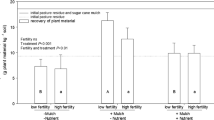Abstract
The effects of crop residue management and fertilizer applications on the size and activity of the microbial community and the activity of exocellular enzymes involved in mineralization of C, N, P and S were examined on a long-term (60 years) field trial under sugarcane situated at Mount Edgecombe, South Africa. Treatments at the site included pre-harvest burning with harvest residues removed (B), burning with harvest residues (unburnt tops) left on the soil surface (Bt) and green cane harvesting with retention of a trash blanket (T). Plots were either fertilized annually with N, P and K or unfertilized. The size and activity of the microbial community and the activity of soil enzymes assayed increased with increasing inputs of crop residues (B < Bt < T) and this effect was evident to a depth of 30 cm. The metabolic quotient was decreased by inputs of both crop residues and fertilizers. Annual fertilizer additions did not affect basal respiration, increased fluorescein diacetate (FDA) hydrolysis rate and acid phosphatase, invertase and protease activities and decreased arginine ammonification rate and dehydrogenase, alkaline phosphatase, arylsulphatase and histidase activities. These effects were attributed to an interaction between the positive effect of fertilizer in increasing the size of the microbial biomass and the negative effect of fertilizer-N-induced soil acidification on microbial activity and on the activity of exocellular enzymes. Such results demonstrate the importance of using a range of measurements of microbial and enzyme activity when determining the effects of management on soil microbial and biochemical properties.








Similar content being viewed by others
References
Alef K, Kleiner D (1987) Applicability of arginine ammonification as an indicator of microbial activity in different soils. Biol Fertil Soils 5:148–151
Anderson JPE (1982) Soil respiration. In: Page AL (ed) Methods of soil analysis, part 2. Chemical and microbiological properties. SSSA, Madison, Wis., pp 837–871
Anderson TH, Domsch KH (1993) The metabolic quotient for CO2 (qCO2) as a specific activity parameter to assess the effects of environmental conditions, such as pH, on the microbial biomass of the soil. Soil Biol Biochem 25:393–395
Beater BA (1962) The sampling and analysis of field sites. South African Sugar Association Experiment Station, Mount Edgecombe, Natal
Casida LE, Klein DA, Santora R (1964) Soil dehydrogenase activity. Soil Sci 98:371–378
Dick RP (1997) Soil enzyme activities as integrative indicators of soil health. In: Pankhurst CE, Doube BM, Gupta VVSR (eds) Biological indicators of soil health. CAB, Wallingford, pp 121–156
Eivazi F, Tabatabai MA (1977) Phosphatases in soils. Soil Biol Biochem 9:167–172
Frankenberger WT, Johanson JB (1982a) l-Histidine ammonia-lyase activity in soils. Soil Sci Soc Am J 46:943–948
Frankenberger WT, Johanson JB (1982b) Effect of pH on enzyme stability in soils. Soil Biol Biochem 14:433–437
Frankenberger WT, Johanson JB (1983) Factors affecting invertase activity in soil. Plant Soil 74:313–323
Franzluebbers AJ, Zuberer DA, Hons FM (1995) Comparison of microbiological methods for evaluating quality and fertility of soil. Biol Fertil Soils 19:135–140
Genstat 5 Committee (1993) GENSTAT 5, release 3 reference manual. Clarendon, Oxford
Goyal S, Chander K, Mundra MC, Kapoor KK (1999) Influence of inorganic fertilizers and organic amendments on soil organic matter and soil microbial properties under tropical conditions. Biol Fertil Soils 29:196–200
Graham MH, Haynes RJ, Meyer JH (2002a) Changes in soil chemistry and aggregate stability induced by fertilizer applications, burning and trash retention on a long-term sugarcane experiment in South Africa. Eur J Soil Sci 53:589–598
Graham MH, Haynes RJ, Meyer JH (2002b) Soil organic matter content and quality: effects of fertilizer applications, burning and trash retention on a long-term sugarcane experiment in South Africa. Soil Biol Biochem 34:93–102
Graham MH, Haynes RJ, van Antwerpen R (2002c) Size and activity of the soil microbial biomass in the row and inter-row area of a sugarcane field under burning and green cane harvesting. Proc S Afr Sug Technol Assoc 76:186–195
Gregorich EG, Carter MR, Doran JW, Pankhurst CE, Dwyer LM (1997). Biological attributes of soil quality. In: Gregorich EG, Carter MR (eds) Soil quality for crop production and ecosystem health. Elsevier, Amsterdam, pp 81–113
Juma NG, Tabatabai MA (1978) Distribution of phosphomonoesterases in soils. Soil Sci 126:101–108
Ladd JN (1978) Origin and range of enzymes in soil. In: Burns RG (ed) Soil enzymes. Academic Press, New York, pp 51–96
Ladd JN, Butler JHA (1972) Short-term assays of soil proteolytic enzymes using proteins and dipeptide derivatives as substrates. Soil Biol Biochem 15:251–256
Nannipieri P (1994) The potential use of soil enzymes as indicators of productivity sustainability and pollution. In : Pankhurst CE, Doube BM, Gupta VVSR, Grace PR (eds) Soil biota. Management in sustainable farming systems. CSIRO, Melbourne, pp 238–244
Raison RJ (1979) Modification of the soil environment by vegetation fires with particular reference to nitrogen transformations: a review. Plant Soil 51:73–108
Rowell DL (1988) Soil acidity and alkalinity. In: Wild A (ed) Russell’s soil conditions and plant growth. Longman, Harlow, pp 844–898
Schnürer J, Rosswall T (1982) Fluorescein diacetate hydrolysis as a measure of total microbial activity in soil and litter. Appl Environ Microbiol 43:1256–1261
Soil Classification Working Group (1991) Soil classification; a taxonomic system for South Africa. Soil and Irrigation Research Institute, Department of Agricultural Development, Pretoria
Sparling GP (1997) Soil microbial biomass, activity and nutrient cycling as indicators of soil health. In: Pankhurst CE, Doube BM, Gupta VVSR (eds) Biological indicators of soil health. CAB, Wallingford, pp 97–119
Speir TW, Ross DJ (1978) Soil phosphatase and sulphatase. In: Burns RG (ed) Soil enzymes. Academic Press: New York, pp 197–250
Tabatabai, A (1994) Soil enzymes. In: Weaver RW, Angle JS, Bottomley PS (eds) Methods of Soil Analysis, part 2. Microbiological and biochemical properties. SSSA, Madison, Wis., pp 775–833
Vance ED, Brookes PC, Jenkinson DS (1987) An extraction method for measuring microbial biomass C. Soil Biol Biochem 19:703–707
Wardle DA, Ghani A (1995) A critique of the microbial metabolic quotient (qCO2) as a bio-indicator of disturbance and ecosystem development. Soil Biol Biochem 27:1601–1610
Acknowledgements
We thank the National Research Foundation of South Africa for partially funding this research and providing a postgraduate bursary for the senior author and Jan Meyer and Rian van Antwerpen of the South African Sugar Association Experiment Station for funding and allowing access to the long-term trash management trial.
Author information
Authors and Affiliations
Corresponding author
Rights and permissions
About this article
Cite this article
Graham, M.H., Haynes, R.J. Organic matter accumulation and fertilizer-induced acidification interact to affect soil microbial and enzyme activity on a long-term sugarcane management experiment. Biol Fertil Soils 41, 249–256 (2005). https://doi.org/10.1007/s00374-005-0830-2
Received:
Revised:
Accepted:
Published:
Issue Date:
DOI: https://doi.org/10.1007/s00374-005-0830-2




